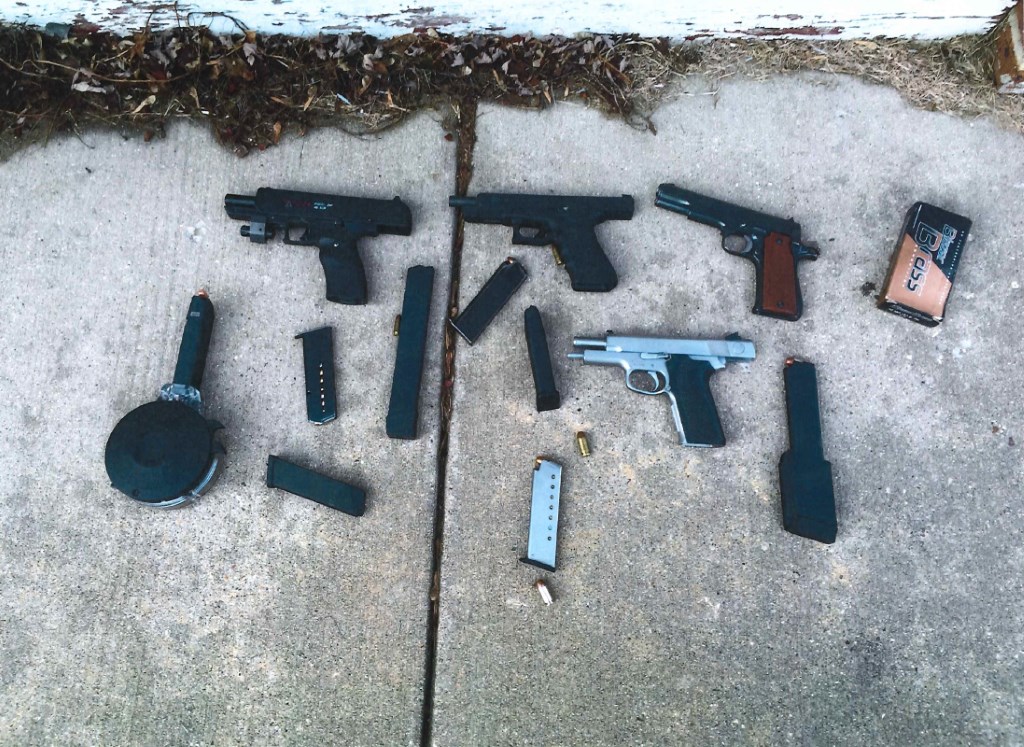State Ranks 2nd for Black Homicide Victims
Study finds Wisconsin has nearly double the national rate and 91% killed with guns.

Guns recovered by the Milwaukee Police Department. Photo courtesy of the Milwaukee Police Department.
Wisconsin is the second worst state in America in the rate of black homicide victimization, a new analysis by the Violence Policy Center found. The homicide rate for African Americans in Wisconsin in 2016 was 37.57 per 100,000 people — “nearly twice the national black homicide victimization rate and more than seven times the overall homicide rate nationwide,” the study found.
Only Missouri had a higher black homicide rate, which was 46.21 homicides per 100,000, compared to the national average of 20.44 per 100,000. By contrast, the overall national homicide victimization rate was 5.10 per 100,000, meaning that African Americans were nearly four times more likely to die of homicides than all other Americans.
“The devastating and disproportionate impact homicide, almost always involving a gun, has on black men, boys, women, and girls in America is a national shame,” VPC Executive Director Josh Sugarmann declares. “These deaths devastate families, traumatize communities, and should provoke an outcry for change.”
This is the sixth year in a row that Wisconsin has ranked among the 10 states with the highest black homicide victimization rates, the analysis notes. Connecticut had the lowest rate, at 9.27 per 100,000 people.
Nationally 87 percent of the victims were men; in Wisconsin men were 67 percent of the victims.
Most of the killings (87 percent nationally) involved the use of guns. In Wisconsin 91 percent involved guns.
“This study highlights just how much work Wisconsin needs to do and just how essential it is that we do that work immediately,” says Jeri Bonavia, executive director of WAVE Educational Fund, which advocates for changes in gun laws “We urgently call on the Wisconsin Legislature to pass evidence-based policies that will save lives in our state.”
Bonavia points to two laws that could help reduce gun violence: requiring a background check for all gun sales (to date, 20 states and the District of Columbia have passed such a law) and a law that prohibits, at least temporarily, people who are at high-risk of committing violence with guns — including those with a history of violent misdemeanors and those with a history of alcohol abuse — from purchasing or possessing firearms.
Criminologists often note that most homicides involve people how know each other, typically during a domestic dispute. In Wisconsin, 66 percent of the black homicide victims knew their assailant and most of those involved arguments between the victim and perpetrator.
In short, most of these murders (71 percent in Wisconsin) are not related to committing some other crime. These are relationship-based events that might not happen if a gun wasn’t readily available to use. “Successful efforts to reduce America’s black homicide toll, like America’s homicide toll as a whole, must put a focus on reducing access and exposure to firearms,” the study argues.
The Violence Policy Center is a non-profit founded in 1988 by Sugarmann, that “works to stop gun death and injury through research, education, advocacy, and collaboration,” its website says.
“The VPC has a long and proven record of policy successes on the federal, state, and local levels, leading the National Rifle Association to acknowledge us as ‘the most effective … anti-gun rabble rouser in Washington,’” the website notes.
However, it has a ways to go with its advocacy. “Shockingly, guns are the only consumer product manufactured in America that the federal government does not regulate for health and safety,” the group notes.
Nationally, the homicide rate has plummeted in the last 30 years, to about half the rate it was in 1990. While the rate declined for all racial groups, the difference in the rate between black and white Americans is still huge. Researchers have found that violence is more likely to arise in neighborhoods with concentrated poverty.
If you think stories like this are important, become a member of Urban Milwaukee and help support real independent journalism. Plus you get some cool added benefits, all detailed here.
Murphy's Law
-
Is Legislature Biased Against Working Class?
 Apr 4th, 2024 by Bruce Murphy
Apr 4th, 2024 by Bruce Murphy
-
Associated Press Will Decline in Wisconsin
 Mar 27th, 2024 by Bruce Murphy
Mar 27th, 2024 by Bruce Murphy
-
City Attorney Race Is Vitally Important
 Mar 25th, 2024 by Bruce Murphy
Mar 25th, 2024 by Bruce Murphy
















